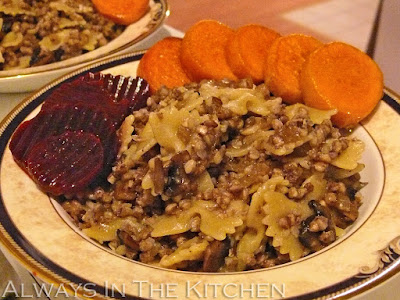
I know it looks as if it might be a ground meat sauce coating those farfalle noodles, but it isn't; those are buckwheat groats. This dish may seem a bit unusual to the uninitiated, but this staple of modern Ashkenazic Jewish cooking is a beloved comfort food favourite for many as either a side dish or a meal in its own right. Meat eating families might have it next to brisket or roast chicken, but it is easily made ovo-lacto vegetarian replacing the chicken schmaltz with butter or vegetable oil, and replacing the chicken stock with mushroom stock or vegetable broth. Even on its own, it is a hearty, filling meal.
According to my *ahem* extensive internet research, this dish is likely a deconstructed take on vareniki, a Ukrainian small, filled dumpling (similar to Russian pelmeni or Polish pierogi). Instead of the time-consuming process of forming the dumplings, the buckwheat filling was just mixed with regular noodles, and a new classic dish was born, with the new name, varnishkes.
Since most recipes start with simply cooking the buckwheat (kasha), I referred back to the successful kasha recipe from a Polish cookbook, then added onions and mushrooms sautéd until darkly golden in chicken fat (collected from a previously roasted chicken) to add layers of flavour to the kasha. Once that was done, I quickly stirred in some cooked pasta, and it was ready to go. This did not take very long to make, but it did use a lot of pots and pans, so a fair bit of washing up was required.
Kasha Varnishkes
Serves 4 - 6
225 grams farfalle (bowtie pasta)
2 medium-to-large onions, finely chopped
2 cloves garlic, finely chopped
10 large cremini mushrooms (or equivalent), halved and sliced
2 tablespoons chicken schmaltz
2 tablespoons butter
1/4 teaspoon salt
1 cup toasted buckwheat groats
1 beaten egg
2 cups strong chicken stock
1/4 teaspoon salt (if your stock is not already salty)
ground black pepper
If your buckwheat groats are not toasted, you can toast them yourself in a dry skillet over medium heat, stirring from time to time, until they smell lovely and toasted. Let cool before proceeding with the recipe.
In a mixing bowl, beat the egg well. Add the cooled, toasted buckwheat groats, and stir until very well integrated.
Heat the chicken stock until boiling.
In a sauce pan with a tight-fitting lid, over medium-high heat, add the buckwheat/egg mixture. Stir continuously, until the grains start to separate themselves from the mass of eggy/buckwheat goo. Then, add the chicken stock, the salt and pepper, and give it one last stir before turning the heat to low, covering, and letting cook for ten minutes. After ten minutes, remove the pan from the heat (leave it covered) and let stand on a cool burner or other safe place for another ten minutes.
While the kasha is cooking, heat the water to boil the pasta, and get started on the onions and mushrooms.
In a large skillet, melt the chicken schmaltz and fry the mushroom slices, in batches, until deeply golden brown. Scrape them to the side of the pan, and add the chopped onions and garlic. Continue to fry, stirring frequently now, until the onions are also turning brown. Taste, and adjust for salt and pepper.
While the onion, garlic, and mushrooms are frying, boil the farfalle until it is cooked to your preference.
Fluff the kasha with a spatula, and add it to the skillet with the onions and mushrooms, and stir through. Drain the farfalle (or use a spider to retrieve them from the water and scoop them directly into the skillet with the kasha mixture. If you happen to have any chicken gold available to you, stirring in a spoonful or two is a wonderful way to add a depth of flavour and sense of luxury to the finished dish. Stir well to coat the noodles with the kasha "sauce" and serve.

We had ours with baked sweet potato coins, and sliced pickled beets.


















